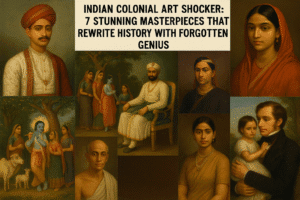Indian Colonial Art Shocker: 7 Stunning Masterpieces That Rewrite History with Forgotten Genius
Delhi’s A Treasury of Life exhibition showcases over 200 “Company Paintings” (1790–1835), blending Mughal craftsmanship with European patronage to document India’s ecology, architecture, and culture. Commissioned by British and French colonizers, these works—created by unnamed Indian artists—capture botanical studies, iconic monuments like Fatehpur Sikri, and vibrant social rituals, merging Mughal detail with Western realism. Highlights include Sita Ram’s architectural panoramas and Sewak Ram’s dynamic Muharram scenes, reflecting hybrid artistic innovation. French-influenced Pondicherry works spotlight Tamil boatmen navigating treacherous seas, underscoring colonial trade’s unsung labor.
While advancing scientific documentation, the paintings also reveal colonial exoticism, reducing traditions to curiosities. Curators argue these pieces mark India’s artistic modernism, as artists transitioned from royal courts to globalized inquiry. The exhibition reclaims marginalized narratives, framing the works as both cultural dialogue and resistance—a testament to India’s adaptive creativity under empire.

Indian Colonial Art Shocker: 7 Stunning Masterpieces That Rewrite History with Forgotten Genius
In a quiet corner of Delhi, an extraordinary exhibition is rewriting the narrative of India’s colonial history—one brushstroke at a time. A Treasury of Life: Indian Company Paintings, c. 1790 to 1835 showcases over 200 artworks that blend Mughal artistry with European curiosity, offering a rare window into the cultural and ecological tapestry of early 19th-century India. These paintings, once dismissed as colonial curiosities, are now being celebrated as the unsung pioneers of Indian modernism.
The East India Company’s Hidden Collaborators
Commissioned by British and French officials, these works were crafted by Indian artists—many unnamed—who had previously served Mughal courts. Stripped of royal patronage after the Company’s ascendancy, these artisans adapted their skills to cater to foreign tastes. The result? A fusion of intricate Mughal miniatures and European realism that documented India’s flora, fauna, architecture, and social customs with startling precision.
“These paintings are more than colonial records—they’re a dialogue between worlds,” says curator Giles Tillotson. “Indian artists didn’t merely replicate European demands; they infused their heritage into every stroke.”
Beyond the Exotic: Stories Embedded in Pigment
The exhibition reveals three dominant themes:
- Natural History: Botanical studies, like those from Murshidabad, capture India’s biodiversity through a scientific lens. Yet, as scholar Nicolas Roth notes, these plants were not just specimens but “pillars of local life,” woven into medicine, cuisine, and ritual.
- Architectural Grandeur: Paintings of Fatehpur Sikri’s dargahs and Agra’s forts served as early “postcards” for European audiences. Sita Ram’s luminous depiction of Sheikh Salim Chishti’s tomb merges Mughal symmetry with Western perspective, reflecting a hybrid aesthetic.
- Cultural Ethnography: From Tanjore’s veena players to Karaikal’s temple processions, these works oscillate between documentation and exoticism. A striking 1822 painting of a female acrobat, mid-performance, underscores the tension—celebrating skill while reducing her to a spectacle.
Regional Flourishes and Forgotten Masters
While British patrons dominate the narrative, French influence in Pondicherry shines through. A dramatic 1800 seascape depicts Tamil boatmen battling surf—a tribute to the unsung nageurs who ferished goods between ship and shore. “These oarsmen were the backbone of colonial trade,” explains art historian Kanupriya Sharma. “Yet their story survives only through art.”
Meanwhile, the rediscovery of artists like Sewak Ram and Sita Ram challenges the anonymity of colonial-era creators. Ram’s vivid Muharram festival scene (1820) pulses with life, transforming a religious observance into a communal tapestry of devotion and diversity.
The Birth of Indian Modernism?
DAG CEO Ashish Anand argues these works mark India’s artistic awakening: “For the first time, artists stepped beyond courts and temples to engage with scientific inquiry.” This shift laid groundwork for later movements, blending tradition with global influences.
Yet the legacy is complex. While the paintings advanced botanical and architectural knowledge, they also perpetuated colonial gaze—framing India as a land to be cataloged and conquered.
Why This Exhibition Matters Today
In an era of reckoning with colonial histories, A Treasury of Life invites viewers to see beyond the patron’s lens. Each painting whispers stories of adaptation, resilience, and cultural negotiation. As Tillotson observes, “They remind us that art is never passive—it’s a battleground of identity and memory.”
You must be logged in to post a comment.